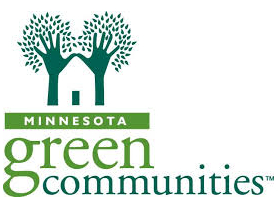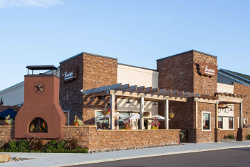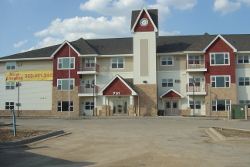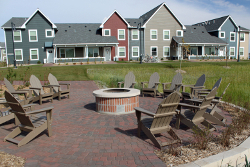SUSTAINABLE BUILDINGS FROM SAND COMPANIES, INC
Green or sustainable building strategies are intended to increase resource efficiency and reduce environmental impacts, but they can also yield cost savings through long-term reductions in operating expenses. Increased energy performance, comfort of occupants and a healthier indoor environment are the major benefits, but increased durability of building components and simplified maintenance requirements can lead to financial efficiencies for our clients. Sand Companies, Inc. believes in "building green with common sense", rather than scoring points on abstract scales.
Maple Village, a 54 unit multifamily housing development in Maple Grove, Minnesota has followed the Minnesota Overlay to the Green Communities Criteria that establishes standards in green building design for the Minnesota Housing Finance Agency. These standards emphasize an integrated design process that involves the developer, architect, engineers, contractor, building management team and LEED Accredited Professional from the very beginning of the design process. SCI involves all these parties on every project, with most of the representatives, including the LEED Accredited Professional, being on staff at SCI. The standards focus on location and neighborhood fabric, site improvements, water conservation, energy efficiency, beneficial materials selections, a healthy living environment and operation and management practice. Examples at Maple Village include high density land use, use of Energy Star appliances, water conserving plumbing fixtures, high efficiency heating systems, extensive use of florescent lighting, and carpets manufactured from recycled from soda bottles.

The building is also served by St. Paul District Energy as its source for heating and cooling. Within the building, use of a simultaneous cooling and heating system based on a two pipe refrigerant system will allow energy transfer for excess heat or cooled air. The major focus however is the reuse of the existing building shell as well as many interior components such as doors, corridors, terrazzo flooring, walls and stairs. SCI completed the work which listed the building on the National Register of Historic Places and renovation is completed under the Secretary of the Interiors Standards for Historic Rehabilitation.
Sand Companies, Inc. staff is regularly expanding and further developing their knowledge of "building green with common sense" solutions which can be applied to every project. Whitney Baethke, an intern architect is a LEED Accredited Professional (LEED AP) who is responsible to guide the development team and owner in sustainable design, including certification of a building through the United States Green Building Council LEED program.




- 366 South Tenth Avenue
P.O. Box 727
Waite Park, MN 56387 - Phone: 320-202-3100
- Fax: 320-202-3139
- Contact Sand Companies, Inc.
Helpful links
Recent News

Sand to break ground on Western U Apartments and Retail
Sand will break ground on the second phase of ...

Sand to add Phase II to Cornerstone Village in St. Michael, Minnesota in summer 2016
Sand teams will start construction on ...
Copyright © 2025 Sand Companies, Inc. All rights reserved. - Professionally Powered by Blue Link Design
